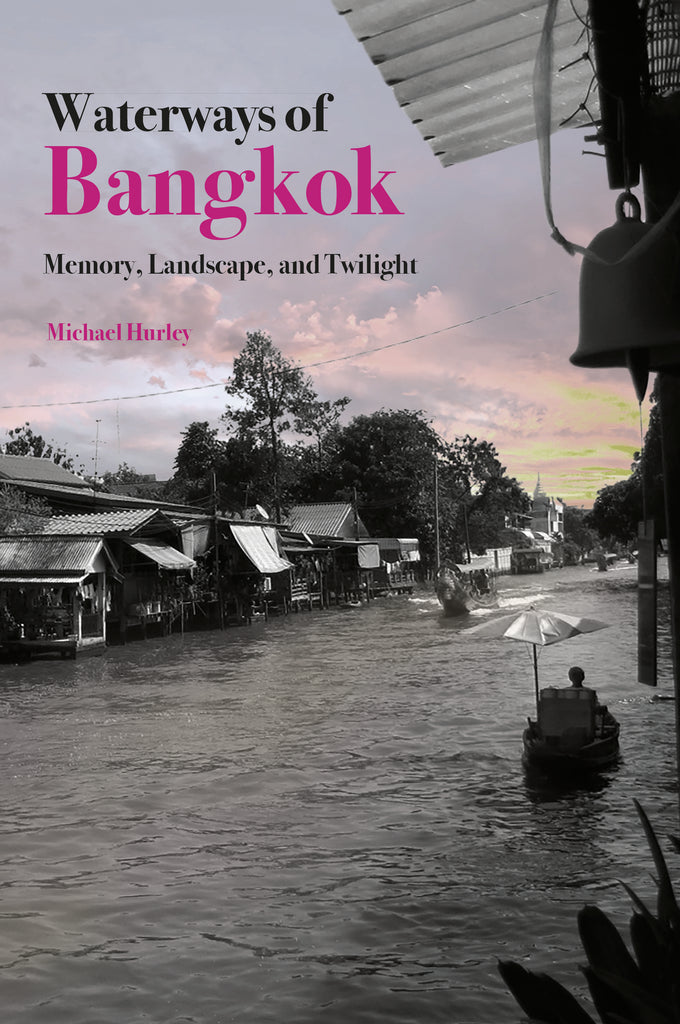The Chao Phraya river, which runs through Bangkok, is the subject of Michael Hurley’s Waterways of Bangkok: Memories, Landscape and Twilights. An ethnographical study of the river, the book portrays not just the river itself, but Bangkok’s relationship with it. Split into five chapters—origins, loss, erasure, belonging and trajectory—the book argues that the Chao Phraya is not just a river, but rather the “binding thread of the Thai heartland, the realm of a traditional way of life, and also enshrined in the state-promoted Thai national story.”
Rivers around the world, Hurley argues, have significant cultural meanings and are rich in historical symbolism. The Chao Praya is no exception. While the Chao Phraya itself is less than 400km in length, its tributaries start from the northernmost reaches of upper Thailand and are of immense historical importance. Thailand’s former kingdoms, Sukhothai, Ayutthaya and Thonburi provide aquatic links from Bangkok to the past. These kingdoms are all directly, or via tributaries, linked to the Chao Phraya river. Sukhothai, for example, which is located several hundred kilometres upstream, is seen by many as the cultural point of origin of Thailand.
Water is central to Bangkok and its foundation as a tropical port city. The Chao Phraya was the conduit for trade from around the world through the Gulf of Thailand. The river was once the backdrop of momentous change to Thailand and home to foreign merchants and the passageway for thousands of Chinese migrants arriving into a rapidly changing Thailand. The riverside, and its many canals, was the economic centre of Thailand and in the late 19th century around 85 percent of Bangkok lived on raft houses. For decades the riverside was the socio-economic centre of Bangkok, yet it has over time shifted eastwards to Sukhumvit. This shift saw rivers move from the front and centre of Bangkok’s socio-economic life to the periphery. The river likewise became dirtier, smellier and no longer something to be proud about. As canals started to be filled in to make roads, the businesses, temples and communities along the riverbanks fell away. The aquatic way of life well away, replaced by gridlock and concrete. There are now frequent laments from older generations that Thais have “no longer know how to live with water.” The once clean rivers full of fish to eat are now full of dirt and chemicals and no longer safe to swim in. Yet for Hurley, this pollution doesn’t mean the river is no longer important, as “pollution, though one deplores it, is a sign of life.”
In many ways this book is about Thai memory, belonging and identity.
Yet the book is not focused on melancholy. Hurley argues that rivers are not just a part of Thailand’s past; they are a significant part of the present. Water still connects communities and there remains a real and perceived bond between waterways and Thai people’s way of life. Even today the Chao Phraya is crossed by skytrains, boats and bridge by millions of commuters on a daily basis. It is this daily interaction with the Chao Phraya that Hurley describes in great detail, painting a vivid picture of the communities along the river’s banks and their changing fortunes.
The book is based on a 2015 dissertation, and its academic background is clear and includes snapshots of his experiences conducting research. As the book is based on the dissertation which is now a decade old, plus several subsequent trips in 2016 and 2017, some political analysis is outdated and a revision based on recent years of political developments would be welcome as book is very much set in the mid to late 2010s. At times, some of the citations and quotations retained from the dissertation could have been reduced for readability and some of the theoretical comparative examples don’t always feel relevant, but it is not written in a dense academic style.
As Hurley moves on to talk about Thai political and cultural identity, the place of minorities within Thai society and the numerous political and economic developments over recent decades, it becomes clear that this book is not really about a river. It contains little to no facts about river ecology or geography. In many ways this book is more about Thai memory, belonging and identity using the river as a narrative device than it is about the Chao Phraya. If you expect a book focused on the river, you may find it lacking, but if you are looking for a meandering, digressive book about Thai history and socio-cultural interactions with water you won’t be disappointed.

